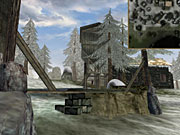Expansion packs tend to get less interesting with each consecutive release after the original game. While successive releases may be more polished, the game's engine gets a little more dated and it's difficult to offer gameplay that isn't repetitive. Expansion packs for role-playing games, in particular, face the difficult task of rekindling interest in the original while offering new environments and adventures that collectively provide only a small fraction of the gameplay offered in the original game. Bloodmoon, the second expansion pack for Elder Scrolls III: Morrowind, largely overcomes those problems by appropriately building upon the strengths of the original game while also providing an ample amount of new territory to explore.

While the previous Morrowind expansion, Tribunal, was set exclusively in a segregated city that wasn't even on the map of the original game, Bloodmoon adds a new island just to the northwest of Morrowind's recognizable landmass. Morrowind's dark elf populace hasn't yet successfully colonized Bloodmoon's island, which is dominated by fierce Nord tribes and barbarians. The beautiful arctic landscape is covered in snow and ice, coniferous trees, and rock formations that appropriately resemble Celtic ruins. The thunderstorms and dusty gales of Morrowind have been supplanted by delicate snowfalls and fierce blizzards. While your character is happily impervious to the setting's frigid temperatures, the change in climate and the distinct terrain make even random exploration interesting. And unlike the Tribunal expansion, Bloodmoon doesn't restrict you from freely exploring the expansion's new landmass. While Tribunal provided a story-driven series of largely sequential quests, Bloodmoon offers more open-ended gameplay and a larger territory for free-form exploration, which were key aspects of the original game's appeal.

Bloodmoon's island is also apparently the Elder Scrolls' equivalent to the Galapagos Islands, since it's populated entirely by unique and interesting flora and fauna. There are more than a dozen interesting new animals and monsters, including packs of wolves, spriggan tree creatures that need to be killed thrice to stay down, and speedy undead draugr. There are no new flying creatures, and the sole water-dwelling animal is largely passive, so explorers don't have to worry about being constantly interrupted by Morrowind's flying cliff racers or pesky fish. If you don't elect to travel through the now tranquil air or water, however, you'll have to deal with hordes of rapidly respawning arctic denizens, since the island is practically overflowing with hostile inhabitants. The creatures are also much more powerful than those in the original game, and battles are rarely duels with solitary enemies, as creatures now frequently attack in groups. Despite these new threats, battles are still relatively brief, bludgeoning affairs if you have a well-equipped adventurer from previous excursions, although you can always increase the challenge using the difficulty slider that was added in a patch after Morrowind's initial release.
If you chose to maximize the details of its impressive graphics, the original game's engine was capable of forcing even the most formidable computer systems to run at occasionally choppy frame rates. Since Bloodmoon features even more detailed and populated environments, the practical system requirements have also been correspondingly increased. You should expect the game to play at least a few frames per second slower when you're traveling outdoors, especially since it's easy to quickly pick up a whole band of hostile pursuers if you're trying to rapidly travel between destinations. While Bloodmoon's additional graphical richness helps to justify the occasionally choppier gameplay, the resulting reduction in frame rates actually worsens one of the main problems that many players had with the original game. The developer also apparently paid minimal attention to sound effects and music, which are almost entirely recycled, although nonplayer characters do occasionally bark commentary that accurately reflects the results of quests or other plot developments, which is a welcome addition.
Bloodmoon does include one of the most frequently requested features of veteran fans of the Elder Scrolls series--it allows player characters to become werewolves. In the previous core game in the Elder Scrolls series, Daggerfall, players could contract lycanthropy or vampirism and adventure as one of those creatures of the night. Morrowind retained the ability to become a vampire and allowed players to partake in a brief series of quests for one of several competing vampire clans. While vampire characters weren't really feasible for ongoing adventures in the original game, since they were ostracized by most guilds and groups that imparted quests, in Bloodmoon, werewolf characters can seamlessly integrate themselves into society provided they are not observed while undergoing a metamorphosis. If sighted changing between man or beast states, your character will be permanently known as a werewolf and attacked on sight by all other characters, even if you promptly assassinate all of the observers. It's an artificial mechanic that compromises the otherwise immersive setting, although it's presumably imposed by the practical limitations of the game engine--it's no different from the treatment already given to careless thieves in the game.

In addition, while vampirism was almost an "Easter egg" secret that many players remained unaware of, werewolves are prominently featured in Bloodmoon, and the main story consists of completely different quests and cutscenes for werewolf characters. Playing as a werewolf is also far more challenging than playing as a regular adventurer, since your health will slowly drain unless you kill at least one NPC nightly, and you're prohibited from using weapons, armor, magical items, or casting spells. While an experienced and well-equipped adventurer will be able to quickly dispatch most of Bloodmoon's threats on the default difficulty level, werewolf characters will have to rely heavily upon stealth, coupled with quick strikes and prudent retreats, just to survive. Werewolves are gifted with enhanced hit points, formidable melee skills, and the ability to sense other characters at great distances, but they receive increased damage from the silver weapons wielded by the native inhabitants. Without magical protection, it's also possible to be rendered helpless by monsters that drain strength such as greater bonewalkers, which are frequently summoned by one of the most common new enemies. The unique werewolf attributes and increased vulnerability, combined with the werewolf's significant role in the setting's lore, make playing as a werewolf a more interesting and challenging alternative to regular adventuring.

If you haven't already installed Tribunal, several interface improvements that were included with that expansion are also provided by Bloodmoon, such as organizing the game's journal by quest and allowing you to annotate the automap. There aren't any new quests for Morrowind's guilds, but Bloodmoon introduces the East Empire Company trader guild, which provides a number of complex quests involving the founding and development of a mining colony. As with some of the guilds in the original game, you have to choose between a few different factions within the guild that have contrasting ethics. Aside from the guild quests and the main plot of Bloodmoon, there are numerous side quests provided by other characters. Several quests also result in changes to the landscape or are prompted by scripted events, which help to make the gaming world feel more dynamic. The new quests are at least as engaging as those in the original game and emphasize the best role-playing aspects of the series.
Bloodmoon restores the original game's most appealing features by offering open-ended gameplay and the opportunity to role-play varied characters in an expansive setting stocked with interesting features. The main storyline is involving, and the arctic setting provides a fresh addition to the lore of the series. While the only truly new feature offered by the expansion is the ability to play as a werewolf, it's a significant and well-integrated gameplay addition. Bloodmoon provides more of everything that made Morrowind a great role-playing game and is the most polished product yet in the series.